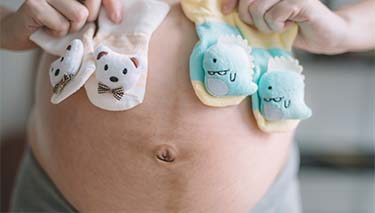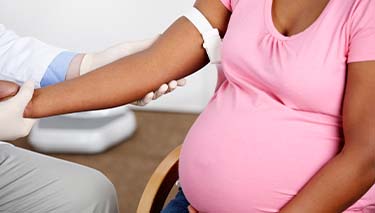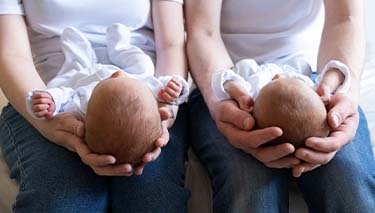Twins are conceived in a different way to singleton babies. From conception, twins are formed when one of two events happen. Either two eggs are released by a woman’s ovaries and fertilised by two separate sperm – these are known as non-identical, fraternal or dizygotic twins. Or, one egg is fertilised by one sperm and this egg splits into two identical halves. These are known as identical, non-fraternal or monozygotic twins.
Identical twins share exactly the same genetic structures and are always the same gender. Non-identical twins can look very different and be the opposite gender. They share the same similarities and differences as any other siblings who have the same biological parents.
Twin development after conception is the same as for individual babies. They will grow and develop at the same rate.
But how will I know what type of twins I’m having?
It is often not clear in the early weeks of a woman’s pregnancy what type of twins she is carrying. Between 5 weeks and 6 weeks pregnant with twins, many women first become aware they are pregnant. Ultrasounds can determine which type of twins are present, but not always. It’s common to not know for sure until twins are born and the placenta/s and membranes are examined.
Twin pregnancy development
Depending on the type of twins a mother is having, her babies may either share an amniotic sac or each baby will grow in their own separate one. They may share a placenta or each has their own. But each baby will have their own amniotic cord. Although it’s unusual, it is even possible for identical twins to have separate amniotic sacs.
Non-identical twins have their own, separate placentas because they were conceived from two completely separate eggs. This is different to identical twins who share the one placenta.
Although most women who are pregnant with twins will have similar experiences, it’s important to remember that every woman and her twin pregnancy will be unique. Genetics, environment, size, and previous obstetric history all play a part. But it is still useful to find out what you can about having a twin pregnancy and how it varies week by week.
How is a twin pregnancy different?
One of the obvious differences about being pregnant with twins is that you will get a lot bigger than if you are carrying only one baby. Your uterus will need to stretch many times from its original size to accommodate two growing babies.
Although the average length of gestation is 38-42 weeks, it is uncommon for twin pregnancies to last until 40 weeks or beyond. The sheer lack of space for two babies to grow any more is often the catalyst for early labour. This is one of the reasons why twins are often premature. There is also an increased risk of maternal complications with a twin or multiple pregnancy. And the risks of these occurring increases with each week of gestation.
Twin pregnancy symptoms
During a twin pregnancy, some changes may be subtle and others more obvious. When carrying twins, it seems that every symptom is multiplied.
With singleton pregnancies the uterus tends to grow at a steady and measured pace. But with twins, for every week which passes, a mother’s tummy increases exponentially. Her increasing weight will reflect this as well, and those creeping numbers are not due solely to the weight of the twins. Her breasts, increased blood volume, the weight of the placenta and amniotic fluid and general increase in body fat stores all need to be accommodated week by week.
Twin pregnancy weeks five – 13
The first trimester
Is the first three months or until 13 weeks pregnant with twins. Extreme nausea is a common experience with twin pregnancies because of the high levels of hCG – Human Chorionic Gonadotrophin hormone. As well as the pregnancy symptoms being more severe, they can also occur much earlier on.
Women with a family history of twins are generally mindful of the possibility. It is not uncommon for women in their first trimester of twin pregnancy to look pregnant. The enlarging uterus lifts and rises out of the pelvis much earlier with two babies than one.
Generally, it’s not until around weeks 5-6 that a woman may suspect she is pregnant. But with twins, the symptoms can be so obvious that she has an earlier pregnancy test. An early positive test is common when pregnant with twins.
Generally morning urine has the highest concentration of hCG.
When 6 weeks pregnant with twins, they can usually be seen on ultrasound.
Symptoms of twins in the first trimester
- Rapidly expanding uterus. Being “large for dates”.
- Weight gain.
- Intense nausea and vomiting, very tender breasts, urinary frequency and extreme tiredness.
- Extreme hunger, appetite fluctuations and sensitivity to particular foods and smells.
Twin pregnancy weeks 14-27
The second trimester
The second or middle trimester lasts from week 14 to week 27. This is often the most enjoyable of the three trimesters – when pregnancy nausea and fatigue has settled but the size of the uterus not too large. Mobility is generally reasonable and walking and sitting isn’t yet an issue.
These are the weeks when many women who are pregnant with twins find they have a renewed sense of energy and optimism, and perhaps for the first time, enjoyment of their pregnancy. Many become excited about the prospect of having twins. When 20 weeks pregnant with twins, you’re reached the ½ way mark.
The initial shock and disbelief has settled and they have become used to the idea. This is also the time when organisation and planning can be done.
Twin pregnancy weeks 28-40
The third trimester
The third trimester spans weeks 28 – 40 of pregnancy. This is when twin pregnancy can become very obvious. Like any singleton pregnancy, individual women will “carry” their twin pregnancy differently. Some seem to just have a neat little bulge at front and others carry their pregnancy from side to side.
Fetal movements can be very strong and seen through the wall of the mother’s abdomen, especially close to term when pregnant with twins. For small, petite women this is more obvious than women who are taller and have a larger frame.
Swelling, fatigue, exhaustion and a lack of general energy are all common symptoms for mothers in their final weeks of pregnancy as they prepare for labour and childbirth.
Complications of twin pregnancy week by week
- Higher risk of miscarriage, especially in the first trimester.
- Higher risk of pregnancy complications such as pre-eclampsia, gestational diabetes, pregnancy induced hypertension.
- Greater risk of labour and childbirth complications.
- Greater risk of Caesarean section delivery.
- Premature birth and complications with the baby.
Written for Huggies by Jane Barry Midwife and Child Health Nurse on 2/05/20.
FAQ
Generally there is an increased likelihood of labour and birth intervention with twins. Caesarian section is more common especially if they are the first babies.
During the second trimester many women say they become more emotionally attached to their twins. The early, fearful weeks have passed and with them, the higher risks of miscarrying.


Last Published* May, 2024
*Please note that the published date may not be the same as the date that the content was created and that information above may have changed since.




















